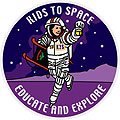05. Could we have such animals as rabbits, hamsters, pigs, chickens and monkeys in space? On space missions, are there - or have there ever been - animals for experiments on board? (A K2S Question)
From The Space Library
Kids2Space (Talk | contribs)
(New page: A large variety of animals were flown to space for science experiments during the 1960s to 1980s and more recently on the Space Shuttle. If sub-orbital flights are included as well as orbi...)
Newer edit →
Current revision
A large variety of animals were flown to space for science experiments during the 1960s to 1980s and more recently on the Space Shuttle. If sub-orbital flights are included as well as orbital flights, dogs, monkeys, mice, chimpanzees, cats, rats, frogs, turtles, crickets, cockroaches, swordtail fish, and rabbits (not to mention plants, fungi, and micro organisms) have been flown. In the pre-Shuttle era, there were attempts to breed rats in space. Pig-tailed monkeys, green tree frogs, and bullfrogs have been in space. Quail eggs were sent to see if they would hatch. Newts, worms, protozoans, toad fish, and a spider named Arabella have traveled to space on Bion and Biosatellite spacecrafts. Arabella was a part of a student experiment which studied how spiders utilize gravity to weave their webs. In 1985, NASA began a series of Space Shuttle flights carrying live animals to space. These studied physical and behavioral changes for symptoms of space adaptation syndrome. US Shuttle Columbia STS- 90 housed a neurolab mission taking along a menagerie of newborn rats, pregnant mice, swordtail fish, snails, prehistoric-looking oyster toad fish, cricket eggs and larvae to study animals' brains and central nervous systems. Science experiments were also flown on US. Shuttle Columbia STS-107, lost in 2003. These experiments included small animals such as silkworms, spiders, carpenter bees, harvester ants, and Japanese killfish, as well as roses, moss and other plants. These animals only exist on Earth; hence, such scientific payload experiments deduce the effects of space environment on their physiology and characteristic behavior. Life as we know it only exists on Earth.
Answer provided by Bijal Thakore
 Question and Answer extracted from the book Kids to Space - by Lonnie Schorer
Question and Answer extracted from the book Kids to Space - by Lonnie Schorer
Buy This Book Click here |

